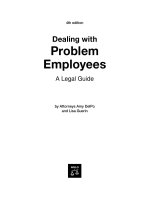every dog’s legal guide, a must-have book for your owner 6th (2007)
Bạn đang xem bản rút gọn của tài liệu. Xem và tải ngay bản đầy đủ của tài liệu tại đây (2.32 MB, 365 trang )
6th edition
Every Dog’s
Legal Guide
A Must-Have Book
for Your Owner
by Mary Randolph, J.D.
Nolo’s Legal Updater
We’ll send you an email whenever a new edition of this book is
published! Sign up at www.nolo.com/legalupdater.
Updates @ Nolo.com
Check www.nolo.com/update to nd recent changes
in the law that affect the current edition of your book.
Nolo Customer Service
To make sure that this edition of the book is the most
recent one, call us at 800-728-3555 and ask one of
our friendly customer service representatives.
Or nd out at www.nolo.com.
The law changes, but Nolo is on top of it! We offer several
ways to make sure you and your Nolo products are up to date:
always up to date
2
1
3
We believe accurate, plain-English legal information should help
you solve many of your own legal problems. But this text is not a
substitute for personalized advice from a knowledgeable lawyer.
If you want the help of a trained professional—and we’ll always
point out situations in which we think that’s a good idea—consult
an attorney licensed to practice in your state.
please note
6th edition
Every Dog’s
Legal Guide
A Must-Have Book
for Your Owner
by Mary Randolph, J.D.
SIXTH EDITION OCTOBER 2007
Cover Design SUSAN PUTNEY
Production SARAH HINMAN
Proofreader PAUL TYLER
Index SONGBIRD INDEXING
Printing DELTA PRINTING SOLUTIONS
Randolph, Mary.
Every dog’s legal guide : a must-have book for your owner / by Mary Randolph.
6th ed.
p. cm.
ISBN-13: 978-1-4133-0703-0 (pbk.)
ISBN-10: 1-4133-0703-5 (pbk.)
1. Dogs Law and legislation United States Popular works. 2. Dog owners
Legal status, laws, etc United States Popular works. I. Title.
KF390.5.D6R36 2007
346.7304'7 dc22
2007013010
Copyright © 1988, 1989, 1994, 1997, 2001, 2005, and 2007 by Mary Randolph.
PRINTED IN THE U.S.A. ALL RIGHTS RESERVED.
No part of this publication may be reproduced, stored in a retrieval system, or transmitted
in any form or by any means, electronic, mechanical, photocopying, recording or otherwise
without the prior written permission of the publisher and the authors.
For information on bulk purchases or corporate premium sales, please contact the Special
Sales Department. For academic sales or textbook adoptions, ask for Academic Sales. Call
800-955-4775 or write to Nolo at 950 Parker Street, Berkeley, CA 94710.
Acknowledgments
I owe the idea for this book to Steve Elias, who also made many good
suggestions on the manuscript.
Editors Jake Warner and Barbara Kate Repa kept me, and the book, going.
Without their sharp minds and sharp wits, this book wouldn’t be half as
good, and writing it wouldn’t have been half as fun.
I’m very grateful to the people who reviewed the manuscript or provided
expertise: my friend Loren Gerstein, formerly a mediator with Community
Boards of San Francisco; Terri McGinnis, practicing veterinarian and author
of e Well Dog Book and e Well Cat Book; Mike Mansel of Insurance
Associates; the late Phyllis Wright of the Humane Society of the United
States; and two dog-lovers, Robin Leonard and Lulu Cornell. Special
thanks to Stanley Jacobsen, a constant source of clippings, good humor, and
M&Ms.
Ella Hirst did extensive and very helpful updating for the fourth edition.
Jackie Mancuso and Susan Putney have both created wonderful covers
for this book. Toni Ihara and illustrator Linda Allison also helped make the
book look so good.
Finally, my thanks to all the people of Nolo, who’ve kept me supplied with
dog cartoons, anecdotes, news stories, and title suggestions (how about “In
Pro Pup” or “Dog Do’s and Don’ts”?).
Table of Contents
I
Introduction 1
1
Dogs and People 3
A Little History 4
e Dog’s Place Today 6
Dogs in the Law 13
2
State and Local Regulation 17
Licenses 19
How Many Dogs Can You Keep? 22
Vaccinations 23
Leash Laws 24
Off-Limits Areas 26
Impounding and Destroying Dogs 27
Lost and Found Dogs 34
Spay and Neuter Requirements 35
Pooper-Scooper Laws 37
Dogs in Vehicles 38
Animal Burial Restrictions 39
3
Buying and Selling Dogs 43
Regulating Sellers 44
Putting a Sale Agreement in Writing 49
Special State “Lemon Laws” 53
Warranties: What Did the Seller Promise? 54
What to Do If You’re Unhappy After the Sale 56
4
Landlords and Dogs 59
Negotiating a Fair Lease 60
Elderly or Disabled Tenants 64
Enforcing No Pets Clauses 67
Condominiums and Planned Developments 73
Landlord Liability for Illegal Evictions 75
Landlord Liability for Tenants’ Dogs 75
5
Veterinarians 85
e Owner-Veterinarian Relationship 86
Health Insurance for Dogs 90
If a Dog Injures a Veterinarian 90
Veterinarians’ Duty to Treat Animals 92
Euthanasia 93
Complaining About a Vet 93
Veterinary Malpractice 94
Other Lawsuits Against Veterinarians 101
6
Traveling With Your Dog 105
e Not-So-Friendly Skies 106
Special Hawaii Rules 119
International Travel 122
On the Road 122
Buses, Trains, and Ships 123
7
Barking Dogs 125
Talking to Your Neighbor 126
Mediation: Getting Another Person to Help 129
State and Local Laws 136
Animal Control Authorities 137
Police 139
Small Claims Court 140
8
Assistance Dogs 157
Types of Assistance Dogs 158
Access to Public Places 161
Rental Housing 164
Assistance Dogs in the Workplace 165
Traveling With Assistance Dogs 166
Exemptions From Local Regulations 167
Income Tax Deductions for Guide Dogs 168
Public Assistance 168
Assistance Dogs and Creditors 169
Penalties for Injuring Guide Dogs 169
9
If a Dog Is Injured or Killed 171
When Killing a Dog Is Justified 173
Unjustified Injury to a Dog 176
Dogs Hurt by Other Dogs 178
If the Dog Owner Is at Fault, Too 179
Compensating the Dog Owner 181
If Your Dog Is Hurt or Killed 191
Lawsuits 195
Claims Against the Government 197
10
Providing for Pets 203
Why You Can’t Leave Money to a Dog—And What Happens If You Try 205
Strategies for Taking Care of Pets 206
Arranging for Veterinary Care 215
Will Provisions at Order Animals Destroyed 217
11
Dog Bites 223
For Dog Owners: How to Prevent Injuries 224
If You’re Hurt by a Dog 226
Dog Owner Liability 228
A Dog Owner’s Legal Defenses 241
Who Is Liable: Owners and Keepers 248
What the Dog Owner Must Pay For 252
Liability Insurance 256
Negotiating With the Owner or Insurance Company 261
Bringing a Lawsuit 262
A Small Claims Court Case 264
Injury to Livestock 272
12
Dangerous Dogs 277
Dangerous Dog Laws 278
Criminal Penalties for Owners of Dangerous Dogs 284
Breed-Specific Restrictions 286
13
Cruelty 291
What to Do If You Suspect Mistreatment 292
Cruelty and Neglect 295
Organized Dog Fighting 304
Scientific Research 305
Killing Animals for Religion or Food 308
Appendixes
1
Legal Research 311
Finding a Statute or Ordinance 313
Finding a Case 314
Background Research 317
State, Local, and Agency Websites 318
2
State Statutes 321
Dog-Bite Statutes 322
Assistance Dogs: Access to Places of Public Accommodation 323
Assistance Dog Access: Housing 324
Index 327
Introduction
e law is a dull dog.
—
T
his book is for people who own dogs, live next door to dogs, get
bitten by dogs, or otherwise deal with dogs—which, with the
American dog population at an estimated 73 million, includes
just about everybody.
Back when most Americans lived on farms or in small towns, few legal
rules affected dogs and their owners. After all, most dogs were unlikely to
run afoul of the law unless they harmed livestock—an offense for which
there were universally harsh penalties.
Not so in modern society. Increasing urbanization has meant stepped-
up animal regulation. In both crowded cities and sprawling suburbia,
there is too much traffic and too little open space to allow dogs to run
loose. And to protect ourselves from dogs whose owners we no longer
know, vaccinations, licenses, and sometimes even liability insurance are
required.
Legal questions come up constantly. What can I do if the dog down
the street barks all night? How many dogs can my neighbor keep? What
can I do if I buy a dog and find out it’s not healthy? Am I legally liable
if my dog bites a child who’s teasing it? Can my landlord, who told me
I could have a dog, evict me for violating the no pets clause in the form
lease I signed?
is book answers many common questions, or shows how to find the
answers as quickly and easily as possible.
Most law that governs animals is local: it is controlled by cities and
counties. State law is involved to a lesser, but increasing, degree, and
federal law hardly at all. So “dog law” varies every time you cross a city
boundary. Obviously, no one book can tell you what the law is in every
town in the country. But we can tell you what to look for and what
to expect, and steer you to the right place or people so you can find it
yourself.
In fact, the local nature of dog law is usually an advantage when
you’re trying to find out the rules in your town. Your legal research may
be as simple as searching your city’s ordinances online or going to the
public library, opening up the big three-ring binder that contains the
city ordinances, and reading the entries under “Dogs.” For questions
that can’t be answered that easily, we offer some legal research tips in
Appendix 1.
A note on endnotes. At the end of each chapter, there are endnotes,
which contain legal citations to important statutes, court decisions,
or interesting articles, so that interested people can look them up for
themselves.
•
2
|
EVERY DOG’S LEGAL GUIDE
Dogs and People
A Little History 4
e Dog’s Place Today 6
Dogs as Companions 6
Dogs as erapists 8
Dogs in the Law 13
1
CHAPTER
F
irst as scavengers, later as companions, servants, and protectors,
dogs have been with us a long, long time. But the fate of dogs
in the crowded modern world is uncertain. Dogs fit easily into
past human societies based on hunting and gathering, and later on
agriculture, but less room is left for them in today’s cities. Forty percent
of U.S. households have at least one dog, according to the American Pet
Products Manufacturers Association. But dogs are now outnumbered
by cats. Writer Cullen Murphy summed up, only half-facetiously, the
broader implications of this shift:
Consider an America congenial to the dog: it was a place of nuclear or extended
families, of someone always home, of children (or pets) looked after during the
day by a parent (or owner), of open spaces and family farms, of sticks and left-
overs, of expansiveness and looking outward and being outside Consider an
America conducive to the cat: it is a place of working men and women with not
much time, of crowded cities, of apartment buildings with restrictive clauses, of
day-care and take-out food, of self-absorption and modest horizons.
1
Increasing intolerance for dogs is shown in more and more laws, which
regulate when dogs must be confined, where their owners may take
them, and even how many may live in a house. But before getting into
the legal rules, here’s a brief look back at the shared history of people and
dogs, and how they’ve come to play such a ubiquitous role in our society.
A Little History
Only two animals have entered the human household otherwise than as prison-
ers and become domesticated by other means than those of enforced servitude:
the dog and the cat.
—
, Man Meets Dog
4
|
EVERY DOG’S LEGAL GUIDE
Most people think they know how dogs came to be part of the human
family: someone living in a cave took in an orphaned wolf puppy and
tamed it. Or wild dogs hung around human encampments looking for
scraps and gradually got tame. Or wolves started hunting in cooperation
with humans and were rewarded with a share of the kill. Probably
none of these theories is accurate. But luckily for all of us who like to
speculate, we may never know for sure.
Experts differ on just when dogs were domesticated. Some say the
evidence indicates domestication as far back as 14,000 years ago. Almost
all agree that the dog was the first—by as much as several thousand
years—domesticated animal.
What wild animal metamorphosed into the modern dog—an animal
we now know so well that its Latin name is Canis familiaris? With the
advent of DNA sequencing, there is no longer much doubt that the gray
wolf (Canis lupus) is the ancestor of the modern dog. Some biologists
even consider them the same species, and dogs have almost certainly
been cross-bred to wolves since domestication.
Dogs are biologically suited to domestication, says one writer,
because of their tendencies toward curiosity, a willingness to move, and
the ability to learn throughout life. ese traits (which are shared by
humans, by the way) allowed them to approach human settlements and
enter into a symbiotic relationship with people.
2
After agriculture replaced hunting and gathering, and permanent
settlements replaced the nomadic way of life, selective breeding of
domestic animals began in earnest. It is that breeding—the human
tinkering with canine evolution—that eventually led to today’s
astonishing variety of domestic dogs. People bred dogs to emphasize
certain desired characteristics and, over the years, developed breeds with
the traits they needed. us the coursing hounds—salukis, greyhounds,
and others—got the long legs, good eyesight, and slender build they
needed to chase prey long distances over open terrain. (Believe it or
not, the original idea was not to have them chase mechanical rabbits
chapter 1 | DOGS AND PEOPLE | 5
around a track.) Other hounds—bassets, beagles, and bloodhounds,
for example—got their extraordinarily keen noses, which enable them
to trail prey. Herding dogs such as collies and sheepdogs were bred for
intelligence and the herding instinct. Toy poodles, Chihuahuas, and
other tiny dogs are scaled-down versions of full-sized ancestors. e list
goes on.
But Don’t Bring Your Dog
e Dog Museum, in St. Louis, Missouri, contains more than 1,500
paintings, photographs, sculptures, and prints of dogs. Browse all you
want—but your dog will have to wait outside.
e museum is located in Queeny Park, at 1721 South Mason Road,
St. Louis, MO 63131, 314-821-3647.
e Dog’s Place Today
Dogs still herd sheep, sniff out drugs, help their disabled owners, and
guard buildings. But the main contribution of most dogs these days
is companionship. Dogs make people smile and laugh, give them
uncomplicated and unconditional love, and stick with them when others
have gone.
Dogs as Companions
Dachshunds are ideal dogs for small children, as they are already stretched and
pulled to such a length that the child cannot do much harm one way or the
other.
—
6
|
EVERY DOG’S LEGAL GUIDE
Studies and surveys of dog owners consistently reach a simple but
important conclusion: Pets make their owners happy. For example,
take a 1984 Psychology Today magazine survey.
3
irteen thousand
readers replied, including enough non-pet-owners (12%), the magazine
concluded, to allow some conclusions to be drawn about differences
between the two groups. Pet owners were more satisfied with their
lives, both past and present. (at result may be partially explained by
demographics: the owners were as a group more affluent, though less
well educated, than the nonowners; also, more of them were married.)
Fifty-seven percent of pet owners, if stranded on a desert island, would
prefer to be with their pet than another person, according to the
American Animal Hospital Association.
4
Hurry Up, Boy, or We’ll Be Late for Work
Almost 20% of American companies let employees bring their pets
to work, says the American Pet Products Manufacturers Association.
Looking for one of those companies? Try www.SimplyHired.com/
DogFriendly.
Many parents get a dog “for the children,” because they believe
that growing up with a dog gives a child companionship and teaches
responsibility, gentleness, and compassion. ey’re right, according to
several studies. For example, a group of preschoolers allowed to care for
a puppy at their school became more cooperative and sharing, according
to the researchers who studied them. “ey have to put themselves in the
pet’s position and try to feel how the pet feels,” explained one researcher.
“And that transfers to how other kids feel.”
5
On a standardized personality test (the Minnesota Multiphasic
Personality Inventory), graduate students who had owned dogs as
children showed significantly higher self-esteem (“ego strength”) than
those who had not had pets. e researcher theorizes that having a dog
chapter 1 | DOGS AND PEOPLE | 7
lets a child form attachments without fear, because of the unconditional
acceptance the dog gives the child. e dog’s trust helps the child trust
himself.
And perhaps children should consider getting a dog “for the parents.”
According to one study of 454 new parents, men who are attached
to their pet dogs also make better fathers. e dog-owning dads
consistently scored higher on tests geared to measure their perceptions of
happiness about their relationship with their babies, their marriages, and
their role as fathers.
ose Brits and eir Dogs
e French may take their dogs to restaurants, but no people love
their dogs more than the British. (Witness all those photos of Queen
Elizabeth with her corgis.) e tens of thousands of pet owners who
responded to an unscientific survey by the BBC in 2004 reported that:
• 65%ofpetownersbuybirthdaypresentsfortheirpets
• 59%ofdogownersletpetssleepintheirbedroom,and
• 59%ofpetownersmisstheirpetsmostwhentheygoaway,
compared to 27% for partners, 11% for children, and 3% for friends.
Dogs as erapists
A psychotherapist would have much to learn from watching the way a dog
listens.
—.
6
Four out of five people who responded to the Psychology Today survey
said that when they were lonely or upset, pets were often their closest
companions. One woman in a difficult family situation wrote that
without her dog, she “could not tolerate life.”
8
|
EVERY DOG’S LEGAL GUIDE
is finding explains why the most striking benefits of an animal’s
companionship are reaped by people who lack close human
relationships: neglected or disturbed children, lonely older people, or
prison inmates. For example, a study of fifth-graders found that for
children who were emotionally neglected, pets served as confidants and
friends—in essence, substitute parents.
7
erapists and administrators now routinely use animals to treat or
manage such patients.
8
But for the most part, animals entered into the
world of psychological therapy serendipitously. One psychiatrist, for
example, happened to have his dog in his office when a young patient
came early for an appointment; the dog became an integral part of the
child’s therapy. In the 1970s, an entire course of research was triggered
when troubled adolescents in an Ohio State University hospital—many
of whom had refused to communicate with the staff—asked to play with
dogs used for behavioral research, which they had heard barking in a
nearby kennel. Even the most withdrawn patients improved after contact
with the dogs.
Get Involved
More and more groups are looking for volunteers to take animals to visit
hospitals, nursing homes, adult day care centers, and special children’s
treatment centers.
For more information, contact a local humane society or erapy Dogs
International at www.tdi-dog.org, or check out www.dog-play.com/
therapy.html.
In one study of children with severe emotional problems, half were
given traditional therapy, and the rest were allowed to play with a dog
during their therapy sessions. e children who received conventional
treatment got worse (as measured by standard tests of ability to control
chapter 1 | DOGS AND PEOPLE | 9
themselves and empathize), but the children who played with dogs got
better.
It is not an exaggeration to say that pets can give people a reason to
live. Often, people institutionalized in prisons or hospitals, for example,
have no goals, no responsibility, no variety in their lives. Animals, either
as visitors or residents, make the atmosphere more home-like and can
have a wonderful, enlivening effect on morale.
An institutionalized person who is allowed to care for a pet may
become more alert, involved, and sociable. As one prison psychiatric
social worker put it, “the therapeutic results are nothing short of
miraculous.”
9
Take the story of Jed, who had been in a nursing home
for 26 years after suffering brain damage in a fall. He was believed deaf
and mute. When he saw Whiskey, a German shepherd-husky dog that
had just been placed in his nursing home, he spoke his first words in 26
years: “You brought that dog.” He began to talk to the staff and other
residents, and to draw pictures of the dog.
10
10
|
EVERY DOG’S LEGAL GUIDE









